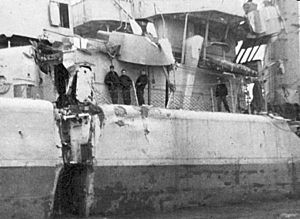Battle of La Ciotat
| Battle of La Ciotat | |||||||
|---|---|---|---|---|---|---|---|
| Part of the Battle of the Mediterranean of World War II | |||||||
 American sailors examining battle damage to USS Endicott after the action off La Ciotat |
|||||||
|
|||||||
| Belligerents | |||||||
|
|
|
||||||
| Commanders and leaders | |||||||
|
|
|
||||||
| Strength | |||||||
| 1 destroyer 2 gunboats 17 PT boats |
1 corvette 1 naval yacht |
||||||
| Casualties and losses | |||||||
|
United States: 1 man wounded 1 destroyer damaged United Kingdom: Unknown |
169 captured 1 corvette sunk 1 naval yacht sunk |
||||||
|
|||||||
The Battle of La Ciotat was a naval engagement in August 1944 during World War II as part of Operation Dragoon. Allied forces, engaged at the main landings in Vichy France, ordered a small flotilla of American and British warships to make a feint against the port city of La Ciotat as a diversion. The Allies hoped to draw German forces away from the main landing zones at Cavalaire-sur-Mer, Saint-Tropez and Saint Raphaël. During the operation, two German warships attacked the Allied flotilla.
On 17 August 1944, the Allied command appointed Captain John D. Bulkeley to take charge of the operation. Bulkeley proceeded to La Ciotat with a force of one destroyer, USS Endicott, 17 PT boats and the British Insect-class gunboats HMS Scarab and Aphis. When the Allies arrived off La Ciotat, the PT boats and gunboats were sent in ahead of Endicott and sank a German merchant steamer in the harbor. The warships then bombarded targets in the city until two German ships were spotted. They were the former Italian Gabbiano-class corvette Antilope, renamed UJ6082 and the former Egyptian armed yacht Nimet Allah. UJ6082 was armed with one 3.9 in (99 mm) gun and two torpedo tubes. Her sister ship UJ6081 had been sunk two days earlier at the Battle of Port Cros. The yacht mounted only a German anti-aircraft/anti-tank 88 mm (3.46 in) Flak gun.
...
Wikipedia
